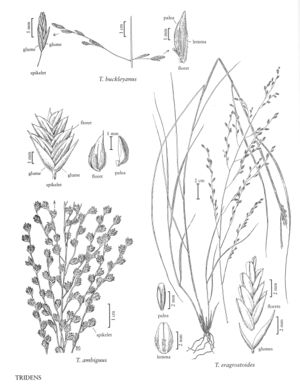Tridens ambiguus
Plants cespitose, with knotty, shortly rhizomatous bases. Culms 60-125 cm. Sheaths rounded or the basal sheaths keeled, glabrous, except for a few hairs on either side of the collar; ligules 1-2 mm, membranous, ciliate; blades 2-5 mm wide, elongate, usually involute distally. Panicles 8-16(20) cm long, 1.5-4 cm wide, not dense; branches to 8(10) cm, erect to divergent, stiff; pedicels shorter than 1 mm. Spikelets 4-6 mm long, pale to dark purple, with 4-6 florets. Glumes 1-veined; lower glumes 4-4.5 mm; upper glumes about 5 mm; lemmas 3-4 mm, veins pubescent to midlength or beyond, midveins excurrent, lateral veins often excurrent; paleas 3-3.5 mm, veins ciliolate, bases bowed-out; anthers 1-1.5 mm. Caryopses 1.5-1.8 mm. 2n = 40.
Distribution
Ga., Tex., La., N.C., Ala., Miss., S.C., Fla.
Discussion
Tridens ambiguus grows on the southeastern coastal plain, from North Carolina to Texas. It is usually found in mesic to perennially moist soils of pine flatwoods and pine-oak savannahs, in seasonally inundated depres¬sions, and at the margins of pitcher plant bogs, often in disturbed sites.
Selected References
None.
